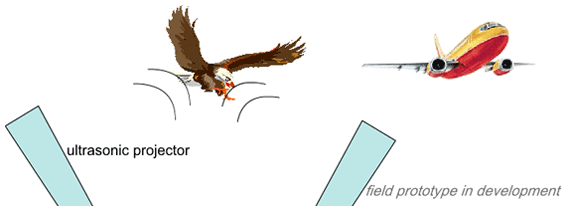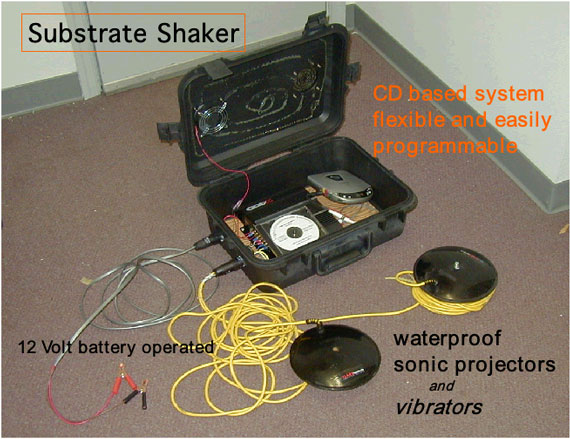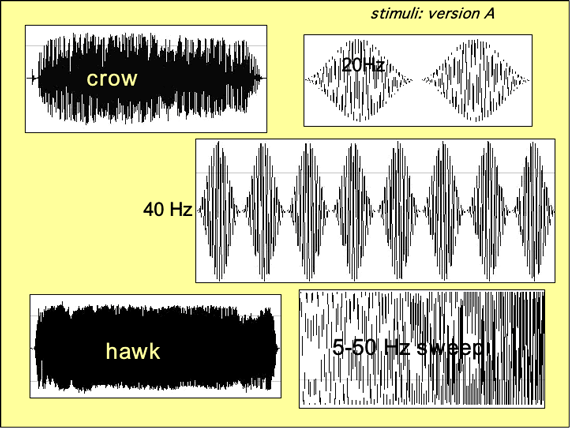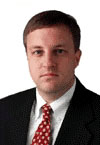Method and Apparatus for Alerting Birds and other Animals, US
6,250,255
|
|
|
|
|
|
|
|
|
|
|
|
|
|
|
|
|
|
|
|
|
|
|
|
|
|
|
|
|
|
|
|
Reducing bird strikes |
|
|
|
|
at the airport |
|
|
with 21st century biotechnology |
|
|
|
|
|
|
|
|
|
|
|
|
|
|
|
|
|
|
|
|
Licensing available from
Virginia Commonwealth University
|
|
|
|
|
|
|
Bird Microwave Hearing
Dizzy beam removes birds
|
|
|
|
|
|
|
|
|
|
|
|
|
|
|
|
|
|
|
Problem
planes: quieter, faster
birds: face into wind
most strikes on landings and takeoffs |
|
- Aviation Safety
- USAF 1 death / 2 years
- 24 died Elmendorf AFB
- Aviation Cost
- USAF > $50 Million / year
- Airlines > $30 Million / year
|
|
|
|
Solution
microwaves: sound at the speed of light
induce attention and dizziness |
 |

Microwave ear and brain responses
birds hear and get dizzy with microwaves
|
|
|
 |
|
Bird sensitivity can be obtained using brainstem evoked potential
technology much like hearing screening in modern hospitals for
infants. This is the equivalent of a bird microwave audiogram.
Dizziness is induced by using very low pulse rates or using the
microwave heating effect. |
Microwave Thresholds
much like mammals
|
|
|
|
|
 |
|
|
Low Power needed for ear effect |
|
Ultrasonic Interaction
producing as new tone at the bird

Principle: two different ultrasonic frequencies will interact
at their intercept (bird) and will produce their frequency sum
and difference. The difference frequency is used to alert the
bird. The difference frequency is also in the beam, and can "follow"
a bird much like a spot light. The ultrasonic beam can be a tone
or amplitude modulated to carry complex sounds such as bird cries.
|
|
|
|
Substrate Shaker
|
|
|
|
|
|
- Very low frequencies for stimulating the bird's body
- Found to be very effective with primitive birds such as waterfowl and pigeons*
|
- Hawk calls can be interweaved with vibration to produce distress
- Crows and passerine distress cries can also be added
|
|
|
|
|
|
|
|
|

A Virginia Commonwealth University Biotechnology


|
|
|
|
|
|
|
|
Virginia Commonwealth University |
|
|
|
|
 |

Aviation Safety
Revised: September 2001
Bird Infrasound (a.k.a. Birdstrike Prevention/Survival)
Bird Infrasound is an SBIR effort that completed Phase I in FY 94 and began Phase II at the end of FY95. Results from the Phase I effort show that birds detect and respond to infrasound, that modulated radar/modulated microwave radiation can be "heard" by people and animals, at higher energy levels birds avoid radar, and it is probable (but not yet proven) that birds will also be able to "hear" modulated radar. Since bird hearing and balance functions are anatomically close together, it might be possible to also have a modulated radar signal that would cause temporary dizziness in birds but have no effect on people or animals. This information will be a key part of future bird control efforts. The use of infrasound signals to alert birds to an aircraft approach and thereby improving their ability to avoid the aircraft is a low cost, low risk, high payoff effort. The Phase II effort will study the effects of infrasound and modulated radar on bird behavior. Infrasound emitted by aircraft, infrasound generators adjacent to runways, and modulated airborne and ground-based radar are all potential ways to reduce aircraft birdstrikes. Modulating radar with an infrasound signal, bird distress calls, and/or a dizziness inducing signal may each be effective in causing birds to avoid aircraft, glide slopes, and runways. A prototype system will be developed, tested, and evaluated in its effectiveness at using infrasound and/or modulated radar in keeping birds away from aircraft. This program will investigate the use of this system by both military and commercial aircraft and airports. The ultimate result from this program is a potential $1B/year savings to worldwide aviation.
Oct 07, 2001
Microwaving birds can be dizzying safety measure
MCGREGOR MCCANCE
TECH NOTES
One of Gene McDonough's Lear jets had just taken off from Washington
when it struck a goose.
The bird hit a leading edge of the jet wing, near its fuselage.
McDonough's pilots were forced to land at the next available airstrip.
The repair bill ran $20,000.
"Almost every pilot has hit a bird," said McDonough, president
of Million Air-Richmond. Based at Richmond International Airport,
the company services, fuels and stores planes.
"Usually, it's just a bloody mark, but those are the small birds.
Big birds can do serious damage," he said. "They can shut a jet
engine down and go through a windshield."
Bird-strike worries are nothing new. Military and commercial airports
have tried different techniques to keep gulls, geese and other
species out of flight paths.
McDonough last week flew to a Quebec City airport. Units lining
the runway there contain propane canisters, which "fire" intermittently
to scare off birds.
But birds acclimate quickly. Yesterday's frightening noise becomes
today's background noise. Ask anyone who has tried gunshots or
fireworks to displace a roost of stubborn buzzards.
After nearly a decade of research and experimentation, a Medical
College of Virginia biomedical engineering professor thinks he
has a permanent solution.
Make the birds dizzy.
Martin L. Lenhardt won a patent in June on the "microwave dizzy
beam" and two accompanying technologies developed to reduce the
number of bird strikes.
He's now searching for an airline or even an insurer that would
test the technology at an airport, help get safety approvals and
eventually make it a commercial product.
"Birds don't like to be dizzy," Lenhardt said. "This is, I think,
our niche to make it effective technology."
The Air Force and a variety of other sources have pitched in a
total of about $1 million in grants since 1993 to advance the
research. Sounds like a lot. But it's not so much, Lenhardt says,
in comparison to the estimated $500 million in annual damage to
U.S. civilian and military aircraft because of bird strikes.
A group formed to raise awareness of the problem, Bird Strike
Committee USA, says more than 400 deaths in the United States
can be linked to strikes.
"This is a worldwide problem," he said. "These things are basically
small bullets. They'll go right through the fuselage of a plane.
The force of a goose hitting an airplane is the same as you driving
into an elephant."
Lenhardt and co-inventor Alfred Ochs of Richmond discovered that
birds react differently to microwave-generated pulses.
Certain frequencies are ignored. But at about 1 gigahertz, a frequency
just above that used by cell phones, audible pulses confuse a
perched bird, which quickly tries to get out of the field. A bird
in flight will twist into circles and also try to flee the irritant.
"Birds are terribly resilient. You've got to avoid the habituation,"
Lenhardt said. "That's the key."
So far the birds have shown no stomach for getting used to microwave
pulses or Lenhardt's other two techniques - the "ultrasonic alerting
beam" and the "shaker startle."
(None of these, Lenhardt says, harm the birds. Unlike an early
technology another scientist had, which relied on a more powerful
microwave beam. The birds basically fell from the sky when they
encountered the beam. Their brains had been cooked.)
The alerting beam works with the dizzy beam. Lenhardt said birds
hear a popping noise, making them alert. That makes the dizzy
beam more effective.
The substrate shaker produces vibrations that birds such as pigeons
and waterfowl find annoying in water or hard surfaces. The device
also can mix in hawk calls, another distressing sound for many
birds.
Important details must be worked out before Lenhardt's technology
is ready for the market.
He, and whomever might sponsor further testing, must prove the
device won't interfere with other communications devices. The
final form of the beam transmitter, whether on the ground near
a runway or in the nose of a jet, is undecided.
Lenhardt figures he must craft a marketing strategy that offers
all three technologies as one package, instead of individual products.
"Airports want something," he said. "It's a matter of getting
this together in a reasonable package."
Gene McDonough, for one, wishes Lenhardt the best of luck.
Contact McGregor McCance at (804) 649-63480 or mmccance@timesdispatch.com
This story can be found at : http://www.timesdispatch.com/business/MGB8541ZHSC.html











